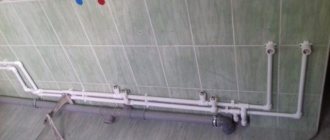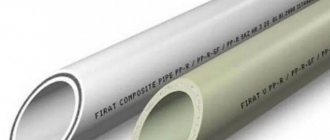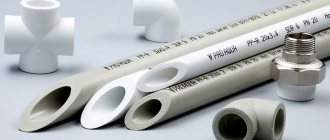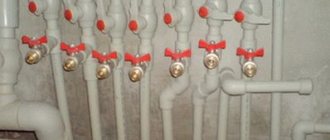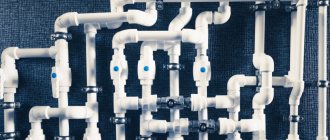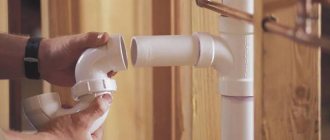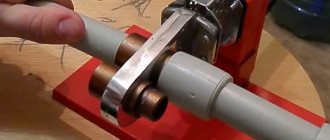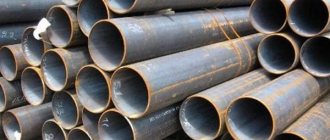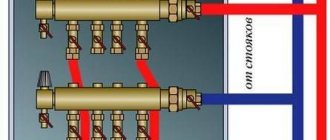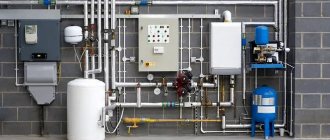Light weight, high throughput and low thermal conductivity determine the main qualities of polymer pipes, which served as the impetus for the widespread replacement of metal products with plastic.
The geometric diameter of polymer pipes is one of the most significant parameters that is taken into account when designing modern heating, sewerage or water supply systems, as well as in pipeline projects for heating mains.
No less important quantities than the diameters of plastic pipes are the wall thickness, the thermoplastic for their manufacture, as well as the parameters of the maximum permissible pressure.
What determines the choice of diameter
The choice of diameter of the PP pipeline depends on:
- purposes of application;
- pressure forces;
- workload;
- number of water sources.
As a rule, the inlet pipe has a diameter of 32 mm. For wiring, PPT 16-20 mm is used. Moreover, the internal diameter of the pipes directly depends on the thickness of their walls, so this parameter is one of the most important when installing a water supply system. For the most accurate representation, there is a special correspondence table.
Diameter of polypropylene pipes table:
For plumbing systems, pipes with an outer diameter of 21 to 25 millimeters are most often used, which is similar to standard steel pipes with a diameter of ½ and ¾ inches. For risers, products with a diameter of 32 to 40 millimeters are used.
There are several types of diameters among polypropylene pipes:
- 16-1200 mm;
- 16-32 mm in the case of household products;
- 40-50 mm for internal sewerage.
The maximum possible pipe diameter is 110 mm. However, it is applied only in the case of arrangement of sewers in large apartment buildings.
The maximum pressure at which a particular polymer pipe can be used is indicated in the marking. For example, the inscription PN10 means that the product should be operated at a pressure of no more than 10 bar, PN20 - no more than 20 bar. In addition, the markings indicate the temperature in degrees.
Polypropylene tubes have a high expansion coefficient: when the temperature changes during the use of the line, the dimensions of the PPT change noticeably.
The internal diameter depends on the permeability of the water supply. The following factors influence the level of cross-country ability:
- internal cross-section (the smaller it is, the weaker the flow);
- total pressure inside the system;
- deposits inside the pipes (depending on the service life of the product);
- number of transitions, turns and joints;
- composition of raw materials PPT (with a smoother surface, pressure and permeability will increase);
- total length of the pipeline (with a large length, the permeability decreases).
The diameter and wall thickness directly depend on the purpose of use and the class of the pipe. To find out the exact diameter, there is a special calculation based on the measurement of hydraulic parameters. The main purpose of this calculation is to obtain the most accurate diameters.
During the calculation, all aspects must be taken into account, including the system structure and operating pressure. For example, pipes for a heating system differ significantly from products for cold water supply. In most cases, for trouble-free operation of the main line without failures, it is necessary to use pipes with a large cross-section, which will increase costs several times. If you ignore the need for a large cross-section, the pressure will noticeably decrease.
Areas of application
Plastic pipes have a fairly wide range of applications. They are used not only for installing water supply systems, but also for other systems. We invite you to get acquainted with the main area of use of such products and their distinctive features.
Plastic pipes are presented in a wide range
Water pipes
The formed structure has a long service life. For its manufacture, various materials can be used, depending on the purpose and location of the work. For household purposes, mainly polyethylene and polypropylene are purchased. In collective industrial enterprises, products made from polyvinyl chloride are used. The features of the listed materials and the recommended area of use will be discussed below.
Polypropylene can be used for plumbing
Sewerage
For the installation of a sewer system, pipes made of PP, PVC, and PE can be used. Standardized sizes make it possible to use various plastic pipes for sewerage. The sizes and prices of such products are closely interrelated: the larger the transverse dimensions, the higher the throughput and cost.
The choice in favor of plastic pipes is made due to:
- resistance to aggressive environments;
- optimal strength characteristics. They are able to maintain their integrity at a meter depth;
- low roughness, reducing the likelihood of blockages and sediment on the inner surface;
- light weight;
- accessibility;
- easy installation.
Sewer pipes must be of the appropriate size
Plastic pipes for heating
The choice in favor of a plastic circuit for the heating system is made due to:
- reducing costs due to a lower degree of heating of the coolant;
- reducing the speed of movement along the heating circuit;
- simplifying installation work.
Before purchasing plastic pipes for heating, you should decide on the optimal diameter and type of system. The throughput of the system and the level of heat loss will depend on this. If the throughput is sufficient, it will be possible to abandon the branched system. When installing a heating circuit with forced circulation, plastic pipes with smaller transverse dimensions are selected: 8–10 mm. Systems with natural circulation will require products with a large cross-section.
For systems with forced circulation, the heating circuit has smaller transverse dimensions
If you are setting up a house or apartment
When creating a project for a standard private house or apartment, there is no need to carry out precise calculations. The number of plumbing fixtures will be minimal, and the difference in price for pipes of different diameters will differ minimally, which will have virtually no effect on the budget.
If you look at the faucet hose, you can see what a small diameter they have, that is, through what minimal holes water flows into the sink. Taking into account the fact that the cross-section of the polypropylene pipe will be much larger, it will always be sufficient, since the bottleneck in this case will be precisely this hose. That is, the patency of the entire system will rest on its narrowest point.
That is why the owners of private houses and apartments do not carry out complex calculations, but simply purchase a polypropylene pipe with a cross-section of 20 mm, saving their precious time. In the vast majority of cases, with a standard number of washbasins, sinks, bathtubs and other plumbing fixtures, such a pipe will be sufficient with a large margin.
We hope everyone understands what diameter polypropylene pipes are measured by. Selecting them will not be difficult. As practice shows, you can often simply purchase the simplest and cheapest pipe - the result will be a high-quality and properly functioning water supply system.
Types of plastic
Connection of plastic pipes.
Several types of plastic plumbing products are widely known. They are based on different types of chemicals:
- PVC pipes are produced based on polyvinyl chloride. Polypropylene pipes are marked with the letters PP, polyethylene pipes - PE, cross-linked polyethylene pipes - PEX. Metal-plastic ones are marked PEX-AL-PEX. PVC pipes are used for hot and cold water supply systems, sewage systems, and are used in the food industry. To connect them, special fittings are used;
- PP polypropylene pipes consist of a working layer, a foil layer and a protective layer, which are connected to each other thanks to perforated foil. Such layered structures have a diameter of 16-125 mm. They are connected by thermoplastic welding. They are used in drinking water supply systems, heating pipelines and compressed air transmission;
- PEX pipes are made using cross-linked polyethylene. They have high strength. Used for installation of heating and water supply systems. Mounted using compression fittings. They are used in snow melting systems and for the installation of heated floors;
- widespread metal-polymer pipes have an additional layer of aluminum foil inside. This layer allows you to significantly reduce the coefficient of linear expansion of the product. When bent, they retain their shape.
Polypropylene pipes are usually supplied in lengths of 4 m and are equipped with fittings. Fittings include tees, adapters, bends, combined couplings, American fittings, flange collars, combs, electric welded couplings, water sockets, crosses and plugs.
Diameters of polyethylene pipes.
The next indicator is diameter. It can be external and internal. Polypropylene pipes are produced with an internal diameter of 5 mm or more. This indicator allows you to calculate the amount of substance that can pass through the pipe per unit time. The outer diameter must be known to prepare a niche for laying the pipeline. for selection of connecting fittings.
- small diameter pipes - from 5 to 75 mm. They are used for installation of water supply and heating systems in private houses and apartments. The most popular in multi-storey residential buildings is the diameter of 32 mm;
- average diameter – 80-315 mm. They are used for sewerage systems, water supply in houses, for transporting various chemical liquids;
- 400 mm and above belongs to the large diameter classification. Such pipes are used to supply large volumes of cold water and for installing ventilation systems. The wall thickness of various polypropylene pipes can be 1.9-18.4 mm. For heating systems, thick walls should be chosen.
Diameters have standard designations. When choosing a suitable diameter, you need to consider:
- interior. This is the main characteristic for the selection of connecting fittings;
- external – divided into small size – 5-102 mm; average – 102-406 mm; large – 406 mm or more. Sometimes the diameter may be indicated in inches.
Inner diameter is an important characteristic. This value helps to select the necessary pipes for the installation of a wide variety of heating systems in everyday life and in production. You can calculate it yourself using the formula: d=sqrt((3.14xQ)(vxdt)). The symbols represent:
- d – required internal diameter;
- Q – heat flow value in kW;
- V – average coolant velocity in meters per second;
- dt – temperature range;
- sqrt – square root.
Polypropylene pipes with a diameter of 110 mm are used in industrial environments. 63 mm - for transporting chemicals and compressed air, as well as for connecting to the boiler room in heating systems. 25 mm – for connecting radiators to a general heating system.
The risers of 5-story buildings are made from pipes 25 mm in diameter. For buildings of 9 or more floors, a diameter of 32 mm is used. In-house wiring is carried out with a diameter of 20 mm. Large diameter pipes are used to supply cold water to several houses. 500 mm or more is suitable for installing a main water supply system supplying water to an entire urban area.
Installation of polypropylene pipelines is carried out using a minimal set of tools. You will need:
- roulette;
- scissors for cutting polypropylene;
- welding electrical device;
- corners;
- couplings;
- taps.
Scissors can be replaced with a hacksaw. The standard welding device is equipped with a set of nozzles for welding polypropylene pipes with a diameter of 20 to 50 mm.
System planning
When developing a design for a heating system for a cottage or house, the area of living quarters and the degree of wall insulation are taken into account. The standard heat rate per square meter is 41 kcal. The technical characteristics of the battery indicate the thermal power of one section. Based on these data, the number of radiator sections is calculated.
Additional calculations include:
- Length of polypropylene pipe routing;
- Number of turns and adapters;
- Availability of thermostats and bypasses;
- Installation of vertical and horizontal structures;
- Connection diagram to the boiler room (bottom, side, two-pipe or single-pipe version.
Important! Ignoring calculations at the initial stage can increase the cost of the project in the future. Extra sections of radiators will create discomfort in the apartment, and an insufficient number of them will result in poor heating.
Materials and characteristics
Knowing the diameter is only half the battle, but when you come to the store, you will be faced with a variety of materials. Polypropylene pipes for heating comply with GOST R 52134–2003. They are made from three types of plastic, two of which can be used for hot water supply and heating systems:
- consisting of identical structural units. Their molecular bonds do not withstand heating and, accordingly, are not applicable for systems with high operating temperatures;
- consisting of different structural units. The heterogeneity of bonds between molecules makes them resistant to heat, while the material does not lose its natural elasticity;
- consisting of crystals. They have the most durable and temperature-resistant structure, but at the same time they lose elasticity.
Be sure to choose reinforced products. Aluminum and fiberglass are used as reinforcement materials. It is better to give preference to the latter, since during installation there is no need to remove the reinforcement layer to the depth of the connection of the circuit with couplings and fittings. Aluminum reinforcement is carried out:
- monolithic layer;
- layer with multiple holes.
Reinforcement of polypropylene with perforated aluminum
Both aluminum and fiberglass reinforcement layers are sandwiched between two layers of plastic. Reinforcement is needed only to compensate for the increase in length of the contour when heated. There is no question of strengthening the product, since the plastic is already very durable. Non-reinforced products are not suitable because they have a too high coefficient of linear expansion, which is 0.15 mm/m. For comparison, for reinforced products it is 0.02 mm/m. Polypropylene pipes for heating have standard sizes. They are sold in lengths of four meters.
For clarity, let's carry out the calculation. Let's take one meter of circuit in which water heated to 80 degrees circulates. Multiply the temperature by the coefficient of linear expansion and get the following values:
- for reinforced products – extension by 1.6 mm;
- for non-reinforced products - extension by 12 mm.
The marking also indicates the nominal pressure. Denoted by the Latin letters PN. For example, a product marked PN16 can withstand 16 atmospheres, but this is not the maximum of its capabilities. It can withstand larger short-term increases. Nominal pressure is the indicator at which the service life of polypropylene pipes will be half a century
The calculation was performed using special programs, where the water temperature is set to 20 degrees. This is important; as the temperature increases, the service life will naturally be shorter, since when the plastic heats up, it changes its mechanical characteristics
Water pipes
Polypropylene pipe products are very often used for arranging water supply circuits in private homes or multi-storey buildings. To properly design the system, clearly calculate the passage capabilities of the channels. This will avoid future accidents and ensure reliable functioning of the water supply system.
When performing calculations, take into account the diameter of the products. But this parameter is not key. Remember that its value is directly proportional to cross-country ability. The larger the structure, the higher the criterion considered.
You also need to take other parameters into account. The most important criterion is the friction index of the carrier on the channel surface. It is different for each type of transported material. In addition, to calculate the parameter under consideration, it is necessary to take into account the difference in pressure at the two ends of the water supply. You also need to take into account the number of shaped products used for arranging the structure.
Calculation of throughput capacity can be carried out in a tabular manner. In one calculation option, the key parameter is the temperature of the liquid. When the temperature changes, the media expands, increasing friction against the channel surface.
The table below will guide you through this method.
The most accurate method for determining the throughput of a polypropylene water supply system is performed using Shevelev tables. They contain not only standard values, but also formulas that allow you to calculate the parameter in question most accurately. They can be used to solve any problems related to the determination of hydraulic parameters. Professionals prefer this technique.
To cope with the task using the mentioned plates, you must take into account:
- purpose of the pipeline;
- line length;
- duration of operation of the circuit;
- pipe wall thickness;
- the value of their internal and external diameters.
Assortment of fittings
Companies specializing in the production of propylene pipes usually produce separate modifications of fittings for them. Depending on the connection method, they are either threaded or designed to connect sections of the main line using a press method.
When choosing a particular type of fitting or coupling, the operating conditions of the pipeline should be taken into account. When you need to connect a water meter or storage tank, you need to purchase a detachable threaded element, and if it is a flexible hose, then it is better to use a permanent type connection.
Types of fittings differ in their purpose and are as follows:
- tees - needed for connecting propylene pipes for heating or arranging their branches;
- couplings - are intended to ensure the transition of pipes from one diameter to another, as well as to threaded connections of products and are used to splice straight sections of utility lines;
- angles - necessary for arranging 45 or 90 degree turns in the pipeline from pipes.
Diameters of polypropylene pipes correspond from external to internal
Polypropylene products differ from other types in their relatively low cost and ease of installation. In addition, pipelines made of this material are not subject to corrosion and deposits, do not conduct electricity, have an aesthetically attractive appearance and very rarely leak. If such a problem occurs, it is associated with errors made during installation.
In addition to indoor water supply and heating systems, polypropylene products are used in ventilation systems, sewage systems, external water supply pipelines, industry and agriculture.
Classification of polypropylene pipes:
- PPH is the first type, made from homopolypropylene, has increased strength, is used in cold water systems, ventilation, and industry
- PPB is the second type, made from a block copolymer, used in ventilation and cold water systems, as well as in heated floors
- PPR - the third type (the most common), made from random copolymer, used for cold and hot water, radiator and underfloor heating
- PPs are a special type that allows internal temperatures up to 95 degrees.
Polypropylene products are also divided into reinforced and non-reinforced. Aluminum foil or fiberglass can be used as reinforcement. The foil can be located near the outer surface or in the middle of the wall.
Diameters of polypropylene pipes: dependence of wall thickness
Before designing a pipeline, you need to know what diameter of polypropylene pipes will be used. There is a complex hydraulic calculation. His goal is to choose the right size for each plot in order to save money when purchasing. The calculation takes into account the operating pressure and structure of the system. A large cross-section, of course, will not harm, but it will be very expensive. If the cross section is too small, the pressure will decrease.
What diameters of polypropylene pipes are there? From 16 to 1200 mm! However, for domestic water supply and heating systems, products with sizes from 16 to 32 mm are used, for internal sewerage - 40, 50 mm or polypropylene pipes with a diameter of 110 mm. The maximum diameter of polypropylene pipes is relevant when installing external sewer pipelines for very large houses or entire neighborhoods.
When designing an internal cold water supply system, the choice of size depends on the length of the pipeline and the number of water supply points. The supply pipe most often has a size of 32 mm; for indoor distribution, the outer diameter of polypropylene pipes is 16 - 20 mm.
No less important is such an indicator as wall thickness. The internal diameters of polypropylene pipes depend on it. The table will help you understand the variety of sizes:
DIY installation of plastic pipes for water supply
When starting to install plastic pipes for water supply with your own hands, you should carefully read the procedure for performing the work. The sequence of actions depends on the type of material used. The connection of polypropylene pipes is carried out as follows:
| Illustration | Description of action |
| Prepare the material of the required size and a special soldering iron. We heat the equipment to operating temperature. | |
| Heat the parts to be joined for 15 seconds. They should not be turned while they are heating. | |
| We connect the fragments together, ensuring the required spatial position. |
Installation of PVC pipes can be carried out using several technologies:
- by “cold welding”, in which it is necessary to use a special chemical composition;
- through the use of special fittings if fragments made of different materials are to be connected;
- bell method. This method is relevant when installing sewerage systems.
Installation features
Since these products do not bend, you should immediately buy polypropylene pipes and fittings to connect them. First, the products are cut to size, taking into account pipeline turns and angles. To fasten two segments, you need to heat the ends with a soldering iron and combine them with a fitting. For aluminum reinforced products, it is necessary to clean the end of the pipe, completely removing the layer of metal from the area that will be inserted into the fitting. This will eliminate the possibility of delamination of the walls.
How to warm up a plastic water pipe in the ground
If the level of insulation is insufficient, the water supply system may freeze in winter. If this happens, you need to know how to warm up a plastic water pipe in the ground so as not to cause damage to it. You can do this as follows:
- disconnect the plastic pipe from the tap;
- heat a large volume of water;
- We insert a smaller diameter hose inside the pipeline. Its length should be sufficient to reach the ice plug;
- We supply heated water from the container inside the hose. The process can be accelerated by using a pressure pump;
- we move the hose inside the water supply as the ice melts.
Instead of a hot pipe, you can use the heat generated as electricity passes through a conductor. However, this method requires certain knowledge and careful adherence to safety precautions.
A frozen pipe can be thawed
Classification by cross-country ability
Additionally, pipes are classified according to permeability. The internal size of polypropylene pipes indicates how much water they can pass in a certain period of time. The external dimensions of the PP pipe in this case do not matter. This suggests that the wall thickness can be any - only how strong the pipes will be depends on this parameter.
How to correctly calculate pipe patency
To calculate the internal diameter of PP pipes, you need to use the following formula:
D = √(4 - Qtotal - 1000/π∙V), where:
Qtotal – maximum total water consumption;
V – speed of water movement.
If the pipes are thick, then the speed is assigned a value of 1.5-2 m/s, but for thin pipes this value is usually equal to 1.2 m/s. That is, the smaller the pipe cross-section, the higher its surface/lumen ratio. In other words, in a thin pipe, almost the entire volume of water will slow down against the walls.
PP pipes with sections of 10-25 mm are selected if the water movement speeds are low. But if the V values are large, then the pipe cross-sections must be at least 32 mm.
In any case, it is advisable to proceed from the highest speeds, since polypropylene has very smooth walls. If a water supply system is installed, then in this case the friction of water on the inner surface of the pipes will be minimal.
The exact values of the permeability and cross-section of pipes are of great importance only in the case of designing a water supply system in multi-storey buildings. If you do not use the table of polypropylene pipe sizes and choose a pipe with a cross-section smaller than the required one, then during periods of peak water consumption, residents will simply be left without water.
However, you may want to take a pipe with a spare cross-section
In this case, it is worth paying attention to the feasibility of such a decision from an economic point of view. Larger diameter pipes will require more expensive fittings
As a result, costs may increase significantly. If you wish, this can be prevented, the main thing is to use a rational approach.
It is not advisable to use PP pipes of large cross-sections in places where thin pipes would be sufficient, again for the purpose of economy. The fact is that when you drain cold water from a tap for a long time, with a larger cross-section of pipe and water, more will be spent before the water becomes hot. If there is no water intake, then a significant part of the heat from hot water will simply dissipate idle.
It is recommended to organize a circulating water supply system, so you will not need to drain the water every time it gets hot. If this is a private house, then you only need to install a simple circulation pump, as well as purchase and equip the system with an additional pipe through which the water will return to the boiler.
There is a huge range of polypropylene pipes on the market for heating and more. If you are making a water supply riser, then polypropylene pipes with a cross-section of 25 mm are suitable if it is a five-story house, and 32 mm for houses from nine to sixteen floors. In this case, when deciding on the diameter, it is worth taking into account the exact number of plumbing fixtures that will be used in this system.
Large cross-section polypropylene pipes are most often used to supply cold water to one or more houses. Polypropylene is not used for laying pipes in heating mains, as it does not like hot water. In addition, this is a place where the pipes will be subject to a large load, which can simply damage the soft polypropylene.
With cold water, everything is much simpler - due to its low temperature and low pressure in the system, cast iron is increasingly being abandoned in favor of polypropylene when installing water pipelines. Quite often you can find systems with a nominal diameter of polypropylene pipes of 500 mm or more, which supply entire small areas.
Recommendations for choosing polypropylene pipes or how to choose the right size
Special calculations will help us in choosing the pipe size, for which we need to know the flow rate of the working medium and the speed of its movement. There are several general schemes with which you can choose the correct diameter. For arranging a sewer system, for example, the table below is suitable:
| Diameter, mm | Filling | Acceptable (optimal slope) | Speed of movement of waste water in the pipe, m/s | Consumption, l/sec |
| 100 | 0,6 | 0,02 | 0,94 | 4,6 |
| 125 | 0,6 | 0,016 | 0,97 | 7,5 |
| 150 | 0,6 | 0,013 | 1,00 | 11,1 |
| 200 | 0,6 | 0,01 | 1,05 | 20,7 |
| 250 | 0,6 | 0,008 | 1,09 | 33,6 |
| 300 | 0,7 | 0,0067 | 1,18 | 62,1 |
| 350 | 0,7 | 0,0057 | 1,21 | 86,7 |
| 400 | 0,7 | 0,0050 | 1,23 | 115,9 |
| 450 | 0,7 | 0,0044 | 1,26 | 149,4 |
| 500 | 0,7 | 0,0040 | 1,28 | 187,9 |
| 600 | 0,7 | 0,0033 | 1,32 | 278,6 |
| 800 | 0,7 | 0,0025 | 1,38 | 520,0 |
| 1000 | 0,7 | 0,0020 | 1,43 | 842,0 |
| 1200 | 0,7 | 0,00176 | 1,48 | 1250,0 |
Temperature can be calculated using this table:
| Pipe diameter, mm | Bandwidth | |||
| By warmth | By coolant | |||
| Water | Steam | Water | Steam | |
| Gcal/h | tons/h | |||
| 15 | 0,011 | 0,005 | 0,182 | 0,009 |
| 25 | 0,039 | 0,018 | 0,650 | 0,033 |
| 38 | 0,11 | 0,05 | 1,82 | 0,091 |
| 50 | 0,24 | 0,11 | 4,00 | 0,20 |
| 75 | 0,72 | 0,33 | 12,0 | 0,60 |
| 100 | 1,51 | 0,69 | 25,0 | 1,25 |
| 125 | 2,70 | 1,24 | 45,0 | 2,25 |
| 150 | 4,36 | 2,00 | 72,8 | 3,64 |
| 200 | 9,23 | 4,24 | 154 | 7,70 |
| 250 | 16,6 | 7,60 | 276 | 13,8 |
| 300 | 26,6 | 12,2 | 444 | 22,2 |
| 350 | 40,3 | 18,5 | 672 | 33,6 |
| 400 | 56,5 | 26,0 | 940 | 47,0 |
| 450 | 68,3 | 36,0 | 1310 | 65,5 |
| 500 | 103 | 47,4 | 1730 | 86,5 |
| 600 | 167 | 76,5 | 2780 | 139 |
| 700 | 250 | 115 | 4160 | 208 |
| 800 | 354 | 162 | 5900 | 295 |
| 900 | 633 | 291 | 10500 | 525 |
| 1000 | 1020 | 470 | 17100 | 855 |
You should be careful with it, since a breakthrough of boiling water means not only a pipe breakage, but also possible injuries. If you have little experience in purchasing polypropylene pipes, it is better to use the following methods:
- Find suitable GOSTs that contain detailed installation requirements.
- Use a calculator. Online calculators are not always able to take into account all the nuances due to their simplicity. To do this kind of work, there are companies that can help you choose.
- Contact a specialist in a specialized store. There may well be people there who are knowledgeable about pipe sizing. If there are no such stores in your locality and everything is ordered online, you can try to clarify all questions via the Internet with qualified specialists.
The ratio of the bore diameters of pipes made of different materials. Sample Pivot Table
Very often, installers and mechanics confuse pipe diameters. I had to see how a mechanic from the housing office insisted that during the alteration the diameter of the pipes in the central heating should not be narrowed, while demanding that everything be passed through as 25 metal (34), but the installers understood this as 25 polypropylene.
Do not forget that in pipes it is the internal diameter that is important, because it determines their throughput.
Below is an approximate summary table of pipes of different diameters and different materials. The most common materials and diameters are taken.
How to use the table: on the left, the vertical column shows the internal diameter, for example, we find 15.6 mm, this internal diameter corresponds to a regular steel pipe 12. PN10 polypropylene with a diameter of 20 mm, 20 mm metal-plastic and 18 mm copper.
By the way, an ordinary pipe in 34 corresponds to polypropylene PN20 with a diameter of 32 mm, which is considered to be inch.
Polypropylene and metal-plastic pipes using information about Wavin pipes from 20 to 40 mm in diameter
Copper pipes were used according to GOST 2005, up to 15mm diameter the wall thickness was 0.8mm, up to 28mm the wall thickness was 1mm, over 28 -1.2mm
The steel pipes used are old GOST from 1975.
Uponor-PEX polyethylene pipes with pressure up to 10 bar for heating and plumbing.
Pipes that are very similar in internal diameter are combined under the closest value.
Perhaps such a table will be useful in calculations.
Main characteristics
Unlike steel profiles, plastic materials do not corrode, do not increase internal resistance, and the loss of fluid pressure due to friction is 30% lower than that of analogues. The pipes are frost-resistant and retain their flexibility when the temperature decreases.
Products made from polymers have low weight, high throughput and low thermal conductivity.
Diameters of plastic pipes for water supply and other overall dimensions
The stress that arises inside the pipe when pumping liquid is directly proportional to the hydrostatic head and the reduced average diameter of the profile and inversely proportional to the thickness of its wall. Therefore, when choosing polymer pipes, you need to take into account that by increasing or decreasing the size of the products, you can exceed the design hydrostatic pressure.
Dimensions of plastic pipes for water supply, table:
| Outside diameter | Wall thickness, mm | ||||
| Polyvinyl chloride | Polypropylene | Metal-plastic | HDPE | Cross-linked polyethylene | |
| 10 | 1,38 | 1,80 | 1,35 | — | 1,28 |
| 12 | 1,38 | 2,00 | 1,65 | — | 1,40 |
| 16 | 1,79 | 2,70 | 2,18 | 3,00 | 1,80 |
| 20 | 2,28 | 3,40 | 2,76 | 3,38 | 2,27 |
| 25 | 2,65 | 4,16 | 3,46 | 4,17 | 2,80 |
| 32 | 3,56 | 5,38 | 4,36 | 5,37 | 3,58 |
| 40 | 4,50 | 6,65 | 5,50 | 6,67 | 4,50 |
| 50 | 5,58 | 8,30 | 6,87 | 8,30 | 5,57 |
| 63 | 7,10 | 10,50 | 8,60 | 10,50 | 7,10 |
| 75 | 8,40 | 12,50 | 10,30 | 12,50 | 8,40 |
| 90 | 10,10 | 15,00 | 12,30 | 15,00 | 10,10 |
| 110 | 12,30 | 18,30 | 15,10 | 18,30 | 12,30 |
Weight
The calculated mass of pipes, structures and connecting elements must correspond to those specified in the regulatory documents. The weight of plastic materials simplifies the assembly of networks and reduces the load on the brackets to which the lines are attached.
Over time, the load-bearing and strength characteristics of the walls decrease. This fact is not always taken into account by installers when choosing fasteners. Incorrect application of the calculated weight of 1 m of pipeline can lead to unpredictable consequences.
Knowledge of the weight standard characteristics of products will allow you to create durable and reliable communications.
Diameters of water pipes.
Strength
The durability of pipes depends on the material used, which is characterized by permissible long-term strength, wall thickness and pipe diameter. Based on these values, the primary stress of the profile wall is calculated, which sets the stability margin. The loss of structural strength depends on temperature, pressure and operating time.
Strength tests of individual samples are carried out in laboratory conditions at a temperature of 20°C, artificially subjecting them to deformation - aging.
The longer the aging time, the higher the durability of the pipeline.
Temperature
Composites have different ranges of maximum operating temperatures, within which the product retains its physical and mechanical characteristics. Changing the permissible application parameters increases the effect of linear elongation, while the pipeline loses its rigidity, the line sags and depressurization of connections may occur.
To avoid such situations, you must strictly adhere to the recommended temperature conditions and, when installing water pipelines, comply with the design standards for the distances between the main supports.
Types of water pipes.
Polypropylene pipes and their main diameters
Previously, only cast iron and galvanized steel pipes were used for the installation of various pipelines. They were replaced by products made of polypropylene. They differ from cast iron in their high degree of reliability, lightness, durability, and low cost. Polypropylene pipes do not conduct electricity. This quality makes them indispensable when connecting washing machines. The completely smooth inner surface prevents debris from accumulating inside them.
Advantages of plastic pipes: durability, anti-corrosion resistance, low thermal conductivity.
Polypropylene has high anti-corrosion resistance. These pipes can transport gas and chemical liquids. Polymer materials are not afraid of temperature changes. They do not burst from freezing in winter and are able to withstand high temperatures. Craftsmen assemble frames for gazebos and greenhouses from such products. The diameter of polypropylene pipes varies. The properties and areas of application of these products largely depend on it.
Options
The standard marking for cast iron pipelines is from DN 50 to DN 400. Products that do not have sockets, that is, with smooth sides, have an increased margin of safety. Their length is three meters. SMU pipes can be produced in lengths of 15 cm or more.
The wall thickness of a cast iron pipe is almost identical to plastic products and is 4-5 mm. However, despite similar dimensions in length, wall thickness and diameter, the weight of the metal structure is 10 times greater than the weight of the plastic pipeline. For clarity, a meter of metal product will weigh about 15 kilograms. Accordingly, a plastic pipe of identical dimensions will weigh only 1.5 kilograms.
How to choose the right diameter for your home line
For polypropylene pipes that will be used in apartment buildings, all calculations of the main line for water supply and sewerage must be made with great care and attention. Accordingly, the higher the water consumption by residents, the larger the diameters of polymer products are used
As a rule, in apartment buildings the following sizes of polypropylene pipe diameters in mm are used:
- for risers of 5-storey buildings Ø25 mm;
- wiring inside buildings – Ø 20 mm;
- for risers of houses of 9 or more floors, PPT Ø 32 mm is used.
For each specific apartment or private house, there is no need to accurately calculate the diameter of the water supply pipes, since there are not many intake points in such premises. In this case, the pipes are selected according to a given specification and have a cross-section larger than the diameter of the mixers.
The diameter of polypropylene pipes for water supply in an apartment or house is selected taking into account the following features:
- for pipeline lengths up to 10 m, the preferred diameter is 20 mm,
- for pipelines 10-20 m - diameter 25 mm,
- with a length over 30 m - diameter 32 mm.
For risers, choose products 32 mm or more.
If necessary, the calculation of a home pipeline can be done using a simple formula, which initially only requires the exact value of water flow and the total speed of the internal fluid flow. We select the internal diameter of polypropylene pipes by basic calculation with the initial data:
- speed of fluid movement along the line;
- water consumption.
The diameter of polypropylene pipes for water supply to an apartment or private house is calculated using the following formula:
In apartments and houses, it is recommended to install heating pipes with a clear diameter of 20 mm, and for a water supply system, the minimum cross-sectional size should be 16 mm. Do not exceed this size to avoid losing compliance with specifications. As for pipes with the largest possible diameter (over 500 mm), there is no need for them at all.
Based on everything described above, you can easily decide on the choice of polypropylene pipe for water supply in each specific case, and make an independent calculation of its diameter, based on a simple formula and data from the table.
Recommended sizes
In order to select the required pipe diameter for sewerage, you can use the recommended values for performing such work. It is important to understand that the information provided may change in any direction and depend on the characteristics and features of the plumbing or sewage system.
When equipping internal sewerage, it is recommended to use the following sizes of PVC sewer pipes, according to the table:
- 11 cm . for the toilet, as well as the riser.
- 4-5 cm . for connecting a bathtub, sink, bidet, sink or shower.
- 2.5 cm . for connecting a dishwasher or washing machine.
- 5 cm for connecting a combined drain or setting up wiring.
- 6.5-7.5 cm . for bends.
When equipping external sewerage, it is recommended to use the diameters of PVC sewer pipes, according to the table:
- 11-16 cm for external pipeline installation (the choice of option depends on the volume of wastewater).
- 15-20 cm . for connecting a sauna or bathhouse.
- 20-30 cm . for connecting the pool.
Where are polypropylene pipes used?
Polypropylene pipes appeared on sale not so long ago, however, they are already very popular.
There are a number of advantages that set them apart from their analogues:
- the material is not subject to oxidation;
- can be used in environments with aggressive conditions;
- low cost;
- do not conduct electric current;
- pipes are easy to lay;
- look great in appearance.
It is worth noting that PP pipes can be used not only as internal water supply.
Additionally, they can be used to arrange:
- Ventilation systems. Even the large outer diameter of polypropylene pipes makes them lightweight, without creating large loads on partitions made of wooden frames and plasterboard sheathing, for example.
- Sewers. The material is not afraid of aggressive substances.
- External water pipes with cold water supply.
Since polypropylene is not as durable as cast iron, it needs protection in some areas. If pipes are laid under roads, it is better to build a reinforced concrete box.
The advantages include the fact that deposits do not accumulate on the inner walls of polypropylene pipes. Due to their elasticity, such pipes will not be damaged by frost.
Types of polypropylene pipes
Polypropylene pipes are divided into types according to the composition of the raw materials and the pressure at which they are used.
Classification of polypropylene pipes (PPP) according to the composition of raw materials, namely the degree of modification of the main polymer with various additives used:
- PPR (PPRS, PPR) - pipes of this type are made from a static copolymer of polypropylene foam with a crystalline molecular structure. These products are resistant to temperature fluctuations from -170 to +1400C, as well as shock loads, so they are often used for plumbing, heating and sewage systems. Diameter sizes from 16 mm to 110 mm.
- PPH - in these products, to impart increased impact strength, modifying additives are mixed with polypropylene: nucleators, fire retardants, antistatic agents. This type with a large diameter is used for external water supply, drainage, and ventilation systems. But these products are not suitable for heating devices because they have a low melting point.
- PPB (block copolymer) - this type of raw material has a structure of blocks of homopolymer micromolecules, differing in composition and structure, which alternate with each other in a certain order. Ultimately, the products acquire an increased degree of impact resistance, which is why they are used for underfloor heating and cold water supply systems.
- PPs (polyphenyl sulfide) - this highest class of polymer with a special molecular structure has increased resistance to stress and overheating, is very wear-resistant and durable. PPs are used for cold and hot water supply, ventilation, and heating systems. The diameter of these polypropylene pipes varies from 20 to 1200 mm.
In this case, the configurations, as well as the external and internal diameters of polypropylene pipes are strictly regulated by GOST.
In the marking of polypropylene pipes, the designations N25, N 20, N10, etc. are found. This indicator allows you to evaluate the resistance of PPT to the pressure of the liquid that is in them.
There are these types of polypropylene pipes based on pressure, which determines what diameter to choose the product:
- РN10 (N10) – with a working pressure on the wall of 1.0 MPa and a polymer thickness from 1.9 to 10 mm. They are used for installing underfloor heating systems and cold water supply with heating up to +45 °C. The diameter of pipes of this type is: external – 20…110 mm, internal – 16…90 mm.
- PN16 - this type of product is rarely used, has a wall pressure of 1.6 MPa. Suitable for cold and hot water with heating of the coolant up to +60 °C.
- N20 (РN20) – products with a working pressure on the wall of 2.0 MPa and a thickness of 16...18.4 mm. The most popular polymer for hot and cold water supply with heating temperatures up to 80 °C. Version: outer diameter - 16...110 mm, inner diameter - 10.6...73.2 mm.
- N25 (РN25) – polypropylene with a working pressure on the wall of 2.5 MPa and reinforcement with aluminum foil. Ideal for installing hot water supply and heating systems with liquid temperatures up to +95 °C. The multilayer structure of these products contributes to high resistance to thermal and shock loads. The diameter of pipes of this type is 13.2...50 mm, outer diameter is 21.2...77.9 mm.
There are also fiberglass reinforced PPT. Such lines do not delaminate during operation, and when assembling a water pipeline, they save time on cleaning up cuts during welding. Polypropylene pipes reinforced with fiberglass mesh are resistant to deformation, have an extended service life, and provide quick and easy installation.
Regulatory technical documents
The design, production and use of polymer products must be carried out in accordance with regulatory documents. In Russia this is GOST R 52134-2003.
The technical conditions apply to pressure water pipes and connecting elements made of synthetic materials. They regulate technical parameters that affect the service life of products. The standard defines the duration of hydrostatic strength of materials, operating conditions measured by a set of temperatures and the time of their influence, as well as pressure parameters.
Use of reinforcement
Reinforcement is one of the ways to give pipes special mechanical properties.
Reinforcement is as follows:
- Aluminum foil layer. It can be either external or located internally.
- Fiberglass layer. As a rule, it has an internal location.
Thanks to the reinforcement, the pipes are more durable, and the amount of their thermal expansion becomes smaller.
Experts recommend paying attention first of all to the fiberglass reinforcement layer. This type of pipe never loses its mechanical strength and does not delaminate, and its installation does not require stripping
This type of pipe never loses its mechanical strength and does not delaminate, and its installation does not require stripping.
Pipe classification
Installation of polypropylene pipe.
- PN 10. They have normal strength. These are polypropylene pipes with thin walls. The range of their application is quite wide. They are highly resistant to high and low temperatures. Can be used for installation of underfloor heating and plumbing systems. Their outer diameter is 20-110 mm, inner diameter is 16.2-90 mm, wall thickness is 1.9-10 mm;
- PN 20. This model is universal. Used for installation of ventilation and hot water supply systems. They can be used for underfloor heating systems. The inner diameter is 10.6-73.2 mm, the outer diameter is 16-110 mm, the wall thickness is 1.6-18.4 mm. In the cold they become fragile;
- PN 25. Polypropylene pipes, reinforced with aluminum foil or fiberglass. They are very durable. Used for installation of central heating systems, external water supply, high pressure air supply systems. Inner diameter – 13.2-50 mm, outer diameter – 21.2-77.9 mm, wall thickness – 4-13.3 mm.
The numbers 20, 10 and 25 indicate the maximum permissible pressure in kg/cm².
Polypropylene drain elements
To regulate the quality of production, which produces plastic sewer pipes of various sizes, the table TU 4926-002-88742502-00 is used. According to the conditions specified in the document, the diameter of the finished product can be 50, 100 and 150 mm. The wall thickness parameter varies from 3 to 5 mm and depends on the value of the circumference. Such products can be used when installing risers, or for organizing a discharge line from a plumbing fixture.
It may be mentioned that well-known global manufacturing companies use polypropylene in the manufacturing process of industrial pipes. The circumference of such products can reach 1.2 meters.
Advantages
- durability. They last 3-5 times longer than steel and cast iron. Their service life is 50 years or more;
- anti-corrosion resistance. Polypropylene does not enter into electrochemical reactions;
- this plastic is a clean material from an environmental point of view;
- it has poor thermal conductivity. This prevents condensation from appearing on the surface of the water supply;
- The products are light in weight. It is 9 times lower than the weight of metal analogues;
- water movement occurs practically without noise;
- installation and installation of systems is extremely simple;
- they can be laid inside and outside the building;
- the internal parts of polypropylene pipes that are in direct contact with water fully comply with all sanitary standards of Russia, the USA, Germany, England, Belgium, Spain and Italy;
- their outer surface does not need painting.
The disadvantages of a polypropylene pipeline include:
- each type of polymer material requires the use of different installation technologies;
- they cannot be used for fire protection purposes;
- not all products can be used for installation of hot water supply and heating systems.
All polypropylene pipes are available in different colors. They come in white, black, gray and green. Color by itself doesn't mean anything. The exception is that black color protects somewhat better from ultraviolet radiation.
GOST requirements
According to GOST requirements, the internal and external walls of polyethylene pipes used in water supply systems must be smooth, without foreign inclusions, cracks, air bubbles, or cavities. Slight waviness or longitudinal stripes on the surface of the pipes are possible, but only if these defects do not affect the wall thickness and do not exceed the maximum permissible deviations. They are available in black or blue. Sometimes you can find black polyethylene pipes with three blue longitudinal stripes, which are distributed evenly around the circumference and represent markings. Gas pipes are distinguished from water pipes by yellow stripes on the same black background.
The purpose of the pipes can be determined by their appearance
Advice from a professional: Painting polyethylene pipes blue or black is necessary to quickly visually distinguish PE water pipes from products for other purposes.
